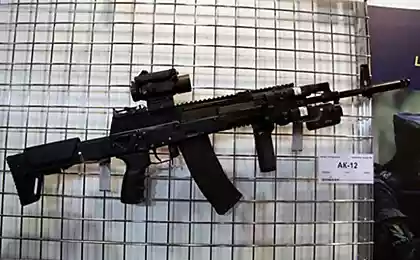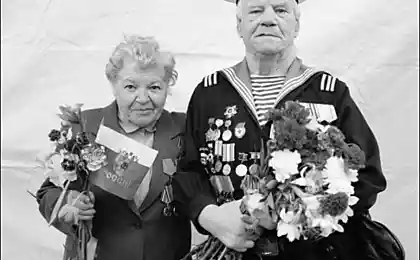718
Birthday grenade grenade
May 16, 1966 the specialists of Tula Central Design and Research Bureau TsKIB MTR logged test dulnozaryadnoy caliber 43 mm mortars, firing fragmentation grenade cumulative. Its peculiarity is that it is specially fastened Kalashnikov.
This proved to be the rare case when the day significantly known appearance of a new type of weapon - grenade. About how it happened, and, most importantly, how to influence the course of military operations, we decided to tell.
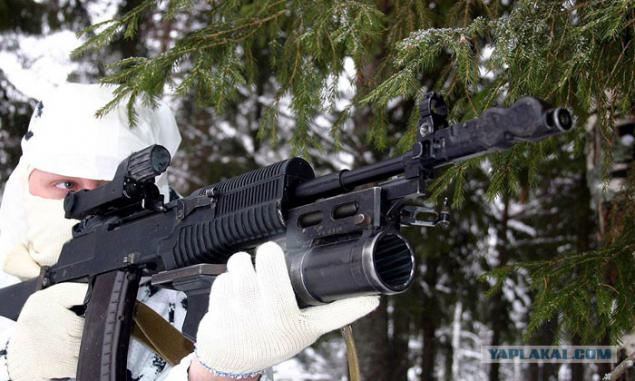
The idea of captain Dyakonova
In the US, and European books on the history of rocket-propelled grenades, it appears the name of captain of the 37th regiment of Yekaterinburg MG Dyakonova. It was he who came up at the beginning of the last century, mortars caliber 40, 5 mm, which are mounted on the barrel 7, 62 mm Mosin rifle and shoot the tiny projectile weighing 370 grams. In the heart of the munition was made pipe for the passage of the bullet.
This snaryadik called rifle grenades could be equipped with an additional charge. This was done in order to impart a high initial velocity. In this case, a grenade flew a distance of 850 meters. If it is pushed only hot powder gases rifle cartridge, the range of its shots did not exceed 300 meters.
It is known that the first grenade was tested Dyakonova December 24, 1916 in the South-Western Front. The soldiers did not like a weapon that requires the utmost care, both in service and in the shooting. "If a grenade is not on the bottom of the mortars, and it happens often, when fired it can fall even five meters - later recalled Bobkov AA Red Army, 95th Infantry Division. - It is necessary to watch her flight, so that the next time to adjust the angle of the rifle. The officer demanded that a grenade exploded at a low altitude over the enemy ».
The complexity and the time required to prepare for the shot, as well as the frequent grenade explosions themselves, led to the fact that the rifle grenade Dyakonova in 1942, was discontinued. Meanwhile, this principle has been implemented in other projects, including a rifle grenade at the US M7 grenade M9 carbine and the Yugoslav M59 / 66 "force".
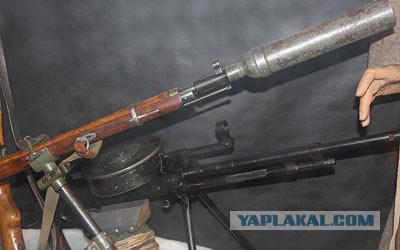
Know-how Design Rebrikova
Victor Rebrikov preparing conventional thesis project, designed for firing mortars and grenade shompolnye stuck it under the barrel AKM - instead of a bayonet-knife. It was in 1963 in the Tula Central Design and Research Bureau sporting and hunting weapons. The project led by the designer Karl V. Demidov, who later became a laureate of the Lenin Prize.
Already in 1966, grenade launcher system Rebrikova was tested, as was recorded in a special register TsKIB MTR "TKB-048, to the AKM mortars shot at TKB-047 - V.V.Rebrikov." There TKB-47 meant the cumulative fragmentation grenade with triple propelling charge, whose author was Demidov. Funding for this development was carried out on "Spark", the name of which was given this grenade launcher. Frag Grenade-cumulative received cipher JAG-40.
By this time, the initial draft has undergone significant changes. In particular, mortars moved from fixing a bayonet-knife at the end of gas chamber and equipped with its trigger mechanism.
The under-barrel grenade launcher "Iskra»
Lieutenant-General E. Smirnov, who was in charge of this development, grenade launcher JAG-40 "Iskra" liked. First of all, because it allows you to cover the enemy fire half at a distance of 50-400 meters. It was just that the distance that lies between the maximum normal throw grenades and minimum range mortar fire. However, after the death of Smirnov's work suspended, because, according to the new curators, grenade launcher dubbed conventional disposable rocket launchers. Plus, he broke ground tests.
And yet, despite the fact that the WGC-40 "Iskra" went down in history as the prototype, it is considered to be the world's first grenade launcher.
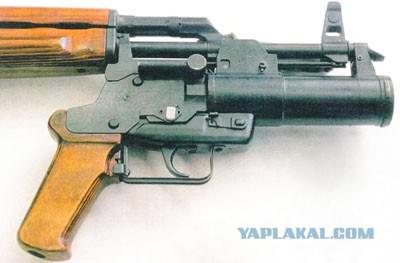
With an eye on the Americans
The Indochina war years 1965-1973 Russian military experts not only helped the Vietnamese troops in their struggle against the American aggressors, but also take a closer look to the weapon of the enemy. In particular, our experts drew attention shtatovskih M203 grenade launcher attached to the rifle M16. It was not even in it in some special characteristics, and that he gave the soldiers of the US Army advanced features in unusual situations.
"In battle, things are changing at lightning speed - recalled Sergeant Joe Cox. - In the heat I did not notice that shot the whole store, and then ... if the Viet Cong out of the ground ... in fifty meters. Reload the rifle, I would not have time. Spas only shot of the M203. For the bad guys it was a complete surprise, and they fell to the ground. Maybe I'm somebody and killed, I do not know. However, this is not important. The main thing is there were precious seconds to retire ».
Meanwhile, the grenade launcher not only further supported the firing of automatic rifles, but also on their own helped destroy pockets of resistance up to 300 meters. And it is of interest to our generals. All the more so in the Soviet Union in the early 1970s were planning and design work on the development of a new AK-74. So it was decided to equip it with the same launcher.
"Fire" by Valery Telesh
For this attracted Tula Designer Valery Telesh, who once developed a box-muffler "Torch" for the grenade "Spark". On a new challenge, he worked together with engineers SSPE "Device" (Moscow).
Interestingly, the authors of a grenade launcher for AK-74, known as FOG-25 "Fire" was not just familiar with Rebrikovym and Demidov, and worked together in the same room. However, they refused to take into account the experience of the "Iskra". In general, without the influence of constructive decisions of the American M203 has not done. In particular, the VOG-25 grenade launcher was no longer controlled device for the production of the powder gases, which would allow to reduce the initial velocity grenades. As a consequence, the minimum distance of the hinged fire increased from 50-70 meters (the "spark") to 200 meters.
But there were also disadvantages. When fired from the "Bonfire", for example, sometimes flew cover receiver Kalashnikov. And yet the whole VOG-25 grenade launcher "Bonfire" to obtain reliable and convenient. In particular, the problem was solved extraction cartridges that simplify maintenance grenade launcher. Successfully solved the problem of security engineers and soldiers when firing. Thus, the fuse grenade cocked only after she flew away at 15 meters from the rocket launcher.
At the same time it was applied design solutions that increase the effectiveness of the shot. When firing a grenade VOG-25P "jumps" over the medium-hard ground and exploded at an altitude of 0 to 75 m, which increased its striking effect. Comparative fire "Bonfire" and shtatovskih M-406 lying on the Rostovs targets showed that the Soviet grenade launcher inflicted wounds conditioned by three to four times more often than the "American».
Grenade launcher against body armor
Over the years, fundamental changes have not undergone grenade launcher. Developments go the way of increasing the destructive power of grenades, as well as creating lighter and more reliable designs. The most popular modern foreign grenade launcher are FN GL1 (Belgium), FN40GL (USA), AG36 / AG-C and HK79 (Germany), Beretta GLX 160 (Italy), LG1 (China) and others. Moreover, many of these developments include the use of rocket-propelled grenades in the form of independent weapons.
With regard to the domestic weapons, the basic Russian grenade launcher today is the GP-34 Production Concern "Izhmash". He decides classic grenade problem and operates in a light mortar.
Meanwhile, in the near future developers will have to take into account the personal protection of nanotechnology. In other words, it is not far off the day when special forces soldiers, dressed in the latest body armor, go into the category of lightly armored units. And to destroy them have to use grenade launchers with special fragmentation grenades cumulative.
Source
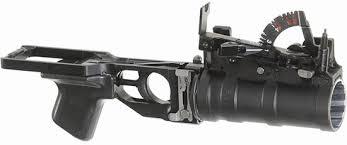
This proved to be the rare case when the day significantly known appearance of a new type of weapon - grenade. About how it happened, and, most importantly, how to influence the course of military operations, we decided to tell.

The idea of captain Dyakonova
In the US, and European books on the history of rocket-propelled grenades, it appears the name of captain of the 37th regiment of Yekaterinburg MG Dyakonova. It was he who came up at the beginning of the last century, mortars caliber 40, 5 mm, which are mounted on the barrel 7, 62 mm Mosin rifle and shoot the tiny projectile weighing 370 grams. In the heart of the munition was made pipe for the passage of the bullet.
This snaryadik called rifle grenades could be equipped with an additional charge. This was done in order to impart a high initial velocity. In this case, a grenade flew a distance of 850 meters. If it is pushed only hot powder gases rifle cartridge, the range of its shots did not exceed 300 meters.
It is known that the first grenade was tested Dyakonova December 24, 1916 in the South-Western Front. The soldiers did not like a weapon that requires the utmost care, both in service and in the shooting. "If a grenade is not on the bottom of the mortars, and it happens often, when fired it can fall even five meters - later recalled Bobkov AA Red Army, 95th Infantry Division. - It is necessary to watch her flight, so that the next time to adjust the angle of the rifle. The officer demanded that a grenade exploded at a low altitude over the enemy ».
The complexity and the time required to prepare for the shot, as well as the frequent grenade explosions themselves, led to the fact that the rifle grenade Dyakonova in 1942, was discontinued. Meanwhile, this principle has been implemented in other projects, including a rifle grenade at the US M7 grenade M9 carbine and the Yugoslav M59 / 66 "force".

Know-how Design Rebrikova
Victor Rebrikov preparing conventional thesis project, designed for firing mortars and grenade shompolnye stuck it under the barrel AKM - instead of a bayonet-knife. It was in 1963 in the Tula Central Design and Research Bureau sporting and hunting weapons. The project led by the designer Karl V. Demidov, who later became a laureate of the Lenin Prize.
Already in 1966, grenade launcher system Rebrikova was tested, as was recorded in a special register TsKIB MTR "TKB-048, to the AKM mortars shot at TKB-047 - V.V.Rebrikov." There TKB-47 meant the cumulative fragmentation grenade with triple propelling charge, whose author was Demidov. Funding for this development was carried out on "Spark", the name of which was given this grenade launcher. Frag Grenade-cumulative received cipher JAG-40.
By this time, the initial draft has undergone significant changes. In particular, mortars moved from fixing a bayonet-knife at the end of gas chamber and equipped with its trigger mechanism.
The under-barrel grenade launcher "Iskra»
Lieutenant-General E. Smirnov, who was in charge of this development, grenade launcher JAG-40 "Iskra" liked. First of all, because it allows you to cover the enemy fire half at a distance of 50-400 meters. It was just that the distance that lies between the maximum normal throw grenades and minimum range mortar fire. However, after the death of Smirnov's work suspended, because, according to the new curators, grenade launcher dubbed conventional disposable rocket launchers. Plus, he broke ground tests.
And yet, despite the fact that the WGC-40 "Iskra" went down in history as the prototype, it is considered to be the world's first grenade launcher.

With an eye on the Americans
The Indochina war years 1965-1973 Russian military experts not only helped the Vietnamese troops in their struggle against the American aggressors, but also take a closer look to the weapon of the enemy. In particular, our experts drew attention shtatovskih M203 grenade launcher attached to the rifle M16. It was not even in it in some special characteristics, and that he gave the soldiers of the US Army advanced features in unusual situations.
"In battle, things are changing at lightning speed - recalled Sergeant Joe Cox. - In the heat I did not notice that shot the whole store, and then ... if the Viet Cong out of the ground ... in fifty meters. Reload the rifle, I would not have time. Spas only shot of the M203. For the bad guys it was a complete surprise, and they fell to the ground. Maybe I'm somebody and killed, I do not know. However, this is not important. The main thing is there were precious seconds to retire ».
Meanwhile, the grenade launcher not only further supported the firing of automatic rifles, but also on their own helped destroy pockets of resistance up to 300 meters. And it is of interest to our generals. All the more so in the Soviet Union in the early 1970s were planning and design work on the development of a new AK-74. So it was decided to equip it with the same launcher.
"Fire" by Valery Telesh
For this attracted Tula Designer Valery Telesh, who once developed a box-muffler "Torch" for the grenade "Spark". On a new challenge, he worked together with engineers SSPE "Device" (Moscow).
Interestingly, the authors of a grenade launcher for AK-74, known as FOG-25 "Fire" was not just familiar with Rebrikovym and Demidov, and worked together in the same room. However, they refused to take into account the experience of the "Iskra". In general, without the influence of constructive decisions of the American M203 has not done. In particular, the VOG-25 grenade launcher was no longer controlled device for the production of the powder gases, which would allow to reduce the initial velocity grenades. As a consequence, the minimum distance of the hinged fire increased from 50-70 meters (the "spark") to 200 meters.
But there were also disadvantages. When fired from the "Bonfire", for example, sometimes flew cover receiver Kalashnikov. And yet the whole VOG-25 grenade launcher "Bonfire" to obtain reliable and convenient. In particular, the problem was solved extraction cartridges that simplify maintenance grenade launcher. Successfully solved the problem of security engineers and soldiers when firing. Thus, the fuse grenade cocked only after she flew away at 15 meters from the rocket launcher.
At the same time it was applied design solutions that increase the effectiveness of the shot. When firing a grenade VOG-25P "jumps" over the medium-hard ground and exploded at an altitude of 0 to 75 m, which increased its striking effect. Comparative fire "Bonfire" and shtatovskih M-406 lying on the Rostovs targets showed that the Soviet grenade launcher inflicted wounds conditioned by three to four times more often than the "American».
Grenade launcher against body armor
Over the years, fundamental changes have not undergone grenade launcher. Developments go the way of increasing the destructive power of grenades, as well as creating lighter and more reliable designs. The most popular modern foreign grenade launcher are FN GL1 (Belgium), FN40GL (USA), AG36 / AG-C and HK79 (Germany), Beretta GLX 160 (Italy), LG1 (China) and others. Moreover, many of these developments include the use of rocket-propelled grenades in the form of independent weapons.
With regard to the domestic weapons, the basic Russian grenade launcher today is the GP-34 Production Concern "Izhmash". He decides classic grenade problem and operates in a light mortar.
Meanwhile, in the near future developers will have to take into account the personal protection of nanotechnology. In other words, it is not far off the day when special forces soldiers, dressed in the latest body armor, go into the category of lightly armored units. And to destroy them have to use grenade launchers with special fragmentation grenades cumulative.
Source











